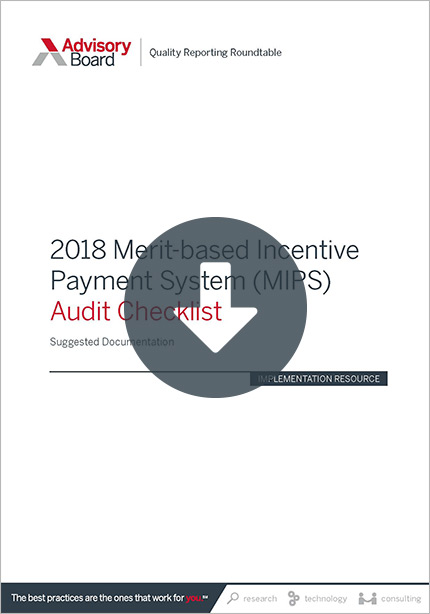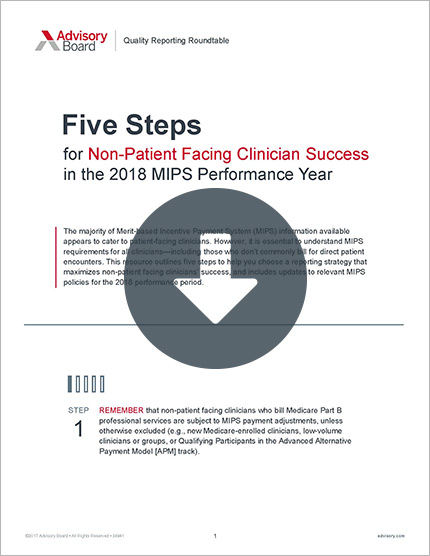Auto logout in seconds.
Continue LogoutRead Advisory Board's take on these results
Ninety-three percent of clinicians eligible to participate in MACRA's Merit-based Incentive Payment System (MIPS) received a bonus payment for the 2017 performance year, CMS Administrator Seema Verma announced in a blog post.
Background
Under MACRA's Quality Payment Program, which took effect in 2017, eligible professionals can choose from two payment tracks:
- The Advanced Alternate Payment Model (Advanced APM) track, for clinicians who take on a significant portfolio of Advanced APMs, which include risk-based ACO models; or
- MIPS, for providers who are reimbursed largely through fee-for-service.
Physicians' pay in the MIPS track largely follows a traditional fee-for-service structure—but CMS adjusts eligible professionals' pay based on how they "score" in four categories of metrics: advancing care information, cost, improvement activities, and quality.
CMS deemed 2017 a "transition year" and required eligible clinicians to submit only 90 days' worth of data. Participating clinicians had the option of submitting data on one quality measure or improvement activity, or four or five advancing care information measures, to meet MIPS requirements. Beginning in 2018, eligible clinicians will need to report on a full year's worth of data.
Eligible providers who met those requirements based on their 2017 data will receive penalties or bonuses of up to 4% beginning in 2019. That percentage will increase up to 5% in payment year 2020 and rise incrementally until it reaches 9% in payment year 2022.
Earlier this year, Verma said 91% of clinicians eligible to participate in MIPS had submitted data in the program's first reporting year.
QPP Year One results
On Thursday, Verma said 93% of the 1,057,824 clinicians eligible to participate in MIPS will receive a positive payment adjustment in 2019, including 71% who earned an additional adjustment for exceptional performance. Verma said 2% of MIPS eligible clinicians will receive a neutral payment adjustment.
According to CMS, 1,006,319 MIPS eligible clinicians reported the required data as either an individual, a group, or through an Alternative Payment Model (APM) and received a neutral or positive payment adjustment.
CMS data show 5% of MIPS-eligible clinicians will see a negative payment adjustment in 2019.
For 2017, eligible clinicians had to receive a score of:
- 70 or higher to receive a positive payment adjustment plus an additional adjustment for exceptional performance;
- 3.01-69.99 to receive a positive payment adjustment;
- 3 points to receive a neutral payment adjustment; and
- 2.99 or less to receive a negative payment adjustment.
Clinicians who participated through an APM had the highest mean score of 87.64, while those participating as individuals or groups not through an APM had a mean score of 65.71. CMS said clinicians in small and rural practices who were not in APMs and participated in MIPS performed well, with average mean scores of 43.46 and 63.08 points, respectively.
In addition, CMS said 99,076 eligible clinicians received a Qualifying APM Participant (QP) status under the Advanced APM track.
'Modest' 2019 positive payment adjustments
Payment adjustments for 2019 will range from 1.88% to -4.0%, according to CMS. In the blog post, Verma acknowledged that the positive payment adjustments are "modest."
She attributed those modest updates to two main events: limited funding available for positive payment adjustments under MACRA, and CMS' decision to make 2017 a transition year to give providers more flexibility to participate. Verma explained, "This measured approach allowed more clinicians to successfully participate, which led to many clinicians exceeding the performance threshold and a wider distribution of positive payment adjustments."
Verma said CMS expects the number of clinicians who are eligible for a positive payment adjustment to decrease as the agency gradually increases performance thresholds (Slabodkin, Health Data Management, 11/9; LaPointe, RevCycle Intelligence, 11/9; Finnegan, FierceHealthcare, 11/8; Leventhal, Healthcare Informatics, 11/8; Verma, CMS blog post, 11/8).
Advisory Board's take


Naomi Levinthal, Practice Manager, Quality Reporting Roundtable, and Ye Hoffman, Consultant, Quality Reporting Roundtable
This news from CMS comes as follow up to their preliminary announcement in the spring that over 90% of eligible clinicians participated in MIPS. Ever since then, providers have been thirsty for more details on participation and to discover overall performance trends among their peers. We've also gone into the available data and member-reported MIPS performance to analyze some of the early results and to weigh in on the maximum adjustments providers could earn.
The data now reported by CMS sheds more light on how the over one million providers in MIPS fared. The key takeaway: the first year was really successful—if success is measured by the percentage of providers that won't be penalized (and see a 4% cut to their Medicare Part B claims starting 2019). However, there's a catch. CMS really eased the transition into the program so much so that for many providers it took little (and sometimes very little) effort to participate at all.
“CMS really eased the transition into the program so much that for many providers it took little effort to participate at all.”
On the other hand, if program success is measured by the potential dollars available to incentivize the highest performers, then perhaps the first year was a different story. Many of our members have told us they felt rather deflated when they had put so much effort into achieving the highest possible performance only to be met with a 1.88% positive adjustment to their Medicare reimbursements in 2019.
However, looking forward, it won't be so easy to avoid a penalty and achieve that highest level of performance in Year 3 of the program. Just last week, CMS released the final requirements for QPP as part of the Medicare Physician Fee Schedule (MPFS) and there is a marked increase in what it will take to earn the maximum incentive.
Join us next month on Tuesday Dec. 4 for our webconference when we dig into the details of the 2019 QPP policies and help you plan for success in future years.
Don't miss out on the latest Advisory Board insights
Create your free account to access 1 resource, including the latest research and webinars.
Want access without creating an account?
You have 1 free members-only resource remaining this month.
1 free members-only resources remaining
1 free members-only resources remaining
You've reached your limit of free insights
Become a member to access all of Advisory Board's resources, events, and experts
Never miss out on the latest innovative health care content tailored to you.
Benefits include:
You've reached your limit of free insights
Become a member to access all of Advisory Board's resources, events, and experts
Never miss out on the latest innovative health care content tailored to you.
Benefits include:
This content is available through your Curated Research partnership with Advisory Board. Click on ‘view this resource’ to read the full piece
Email ask@advisory.com to learn more
Click on ‘Become a Member’ to learn about the benefits of a Full-Access partnership with Advisory Board
Never miss out on the latest innovative health care content tailored to you.
Benefits Include:
This is for members only. Learn more.
Click on ‘Become a Member’ to learn about the benefits of a Full-Access partnership with Advisory Board
Never miss out on the latest innovative health care content tailored to you.


